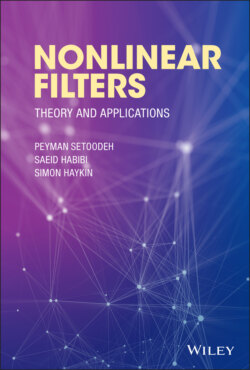Читать книгу Nonlinear Filters - Simon Haykin - Страница 36
3.4 Sliding‐Mode Observer
ОглавлениеThe equivalent control approach allows for designing the discrete‐time sliding‐mode realization of a reduced‐order asymptotic observer [37]. Let us consider the following discrete‐time state‐space model:
(3.20)
(3.21)
where , , and . It is assumed that the pair is observable, and is full rank. The goal is to reconstruct the state vector from the input and the output vectors using the discrete‐time sliding‐mode framework. Using a nonsingular transformation matrix, , the state vector is transformed into a partitioned form:
(3.22)
such that the upper partition has the identity relationship with the output vector:
(3.23)
Then, the system given in (3.20) and (3.21) is transformed to the following canonical form:
(3.24)
where
(3.25)
(3.26)
The corresponding sliding‐mode observer is obtained as:
(3.27)
where , and is the observer gain. Defining the estimation errors as:
(3.28)
and subtracting (3.27) from (3.24), we obtain the following error dynamics:
(3.29)
According to (3.29), the state estimation problem can be viewed as finding an auxiliary observer input in terms of the available quantities such that the observer estimation errors and are steered to zero in a finite number of steps. To design the discrete‐time sliding‐mode observer, the sliding manifold is defined as . Hence, by putting in (3.29), the equivalent control input, , can be found as [37, 38]:
(3.30)
Applying the equivalent control, , sliding mode occurs at the next step, and the governing dynamics of will be described by:
(3.31)
which converges to zero by properly choosing the eigenvalues of through designing the observer gain matrix, . In order to place the eigenvalues of at the desired locations, the pair must be observable. This condition is satisfied if the pair is observable. This leads to a sliding‐mode realization of the standard reduced order asymptotic observer [37].
In (3.30), is unknown. Therefore, the following recursive equation is obtained from (3.29) to compute :
(3.32)
Now, the equivalent observer auxiliary input can be calculated as:
(3.33)
where is obtained from (3.32). Given , the discrete‐time sliding‐mode observer provides the state estimate as [37]:
(3.34)
